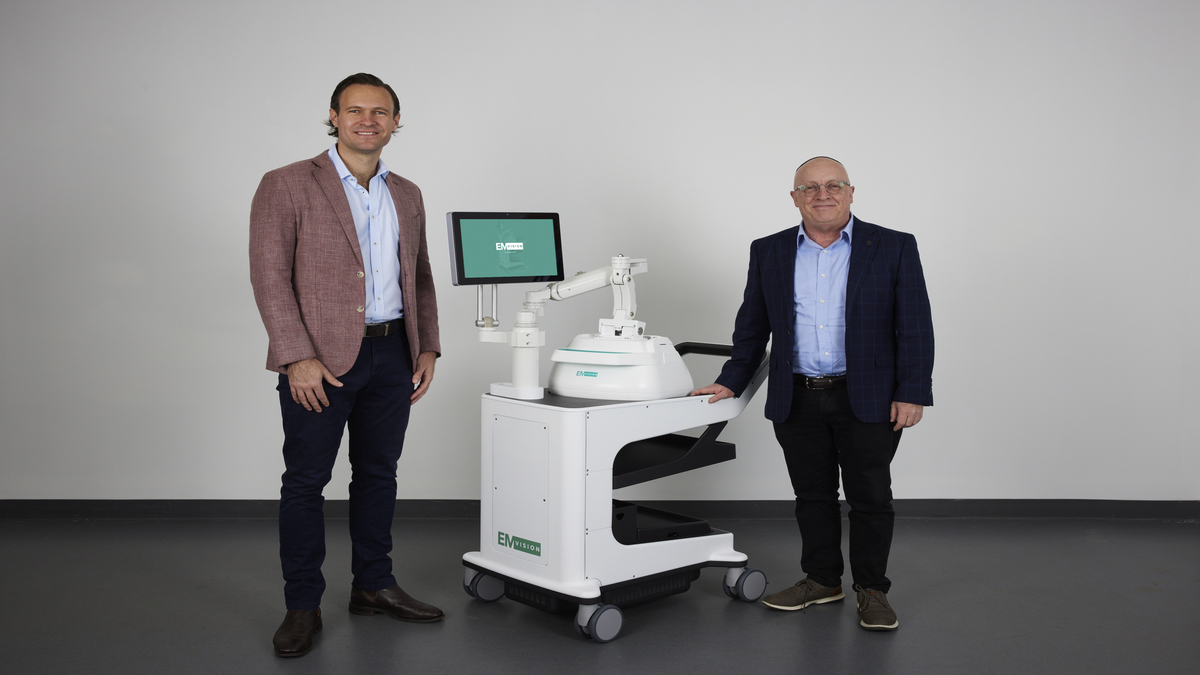Q+A: EMVision on its groundbreaking brain scanner, which could be available in hospitals by 2023

EMVision co-founder Scott Kirkland (L) and CEO Dr Ron Weinberger (R) with the 1st Gen brain scanner device. Pic: Supplied
EMVision (ASX:EMV) is developing a portable brain scanner called the 1st Gen, a device for use in ICUs, stroke and neurology wards, angiogram suites, and emergency departments,
The underlying IP is the brainchild of a large team led by co-inventors at the University of Queensland (UQ) including Professor Amin Abbosh, who is considered a global leader in electromagnetic microwave imaging, along with Professor Stuart Crozier who has created IP central to most MRI machines, and Dr Konstanty Bialkowski, an expert in microwave imaging and near-field radar.
In an interview with Stockhead, executive director and co-founder Scott Kirkland discusses the challenges facing traditional neuroimaging in hospitals and how EMVision is trying to close the gap.
Can you tell me the background story of how it all began?
“The hypothesis proposed by the UQ researchers was that low-power, non-ionising electromagnetic waves could be harnessed to produce, in a short amount of time, a sufficiently clear image of the human brain that in the first instance would allow healthcare professionals to quickly to determine if a stroke has occurred, and if so locate the site of the stroke, and most importantly to distinguish whether it was haemorrhagic (from bleeding) or ischaemic (from clotting),” Kirkland said.
“What really set this approach apart was the ability to create these images using low-cost hardware, including small antennas, much of which was borrowed from the communications industry.
“The confluence of having algorithm, microwave imaging, and antenna experts all in the same location at UQ, and very engaged clinical collaborators at the Princess Alexandra Hospital, just 10 minutes down the road, really enabled the early technology development to take off in the right direction.
“The clinical and industry demand for portable neuroimaging for stroke has in many ways been driven by the progress achieved in pharmacological and surgical interventions for stroke that, if applied early enough, can effectively reverse the stroke.
“These powerful treatments can save lives and dramatically reduce rates of permanent disability. However, before they can be applied, urgent neuroimaging is required to determine stroke type. Thus, the notion of bringing neuroimaging to the patient, speeding up time to diagnosis and time to treatment, when time matters, is very compelling,” he said.
“After the better part of a decade of R&D the UQ team had advanced the technology to such a level that it was ready to exit the lab and enter the clinical development and validation phase.
“That’s when EMVision was formed and we assembled a team of ‘MedTech warriors’, led by our CEO Dr Ron Weinberger (ex-Nanosonics MD).
“Our team has a strong track record in taking novel medical devices from concept through product development, clinical validation, international regulatory approvals, and on to global commercialisation.
“Finding people with the expertise that have done this before, and done so successfully, has been critical to our progress thus far.”
How does the technology work?
“Our technology uses electromagnetic (EM) waves on the microwave spectrum to rapidly create images that can be used for clinical decision making,” he said.
“The device has a headset which sits on a patient’s head, has a ring of antennas within it that act as both transmitters and receivers, which send harmless EM waves into the brain.
“These EM waves propagate through the brain, interacting with the tissue and tissue boundaries. The electrical properties of tissue, and importantly the differences in these properties between tissues, have a strong influence on the “signals” that are sent/received.
“The signals are used to rapidly create images of the brain and leveraged by AI driven classification algorithms to determine stroke type. Importantly, our technology is non-ionising, which allows for frequent safe scanning, and energy output is less than 10% of a mobile phone.”
What are the challenges facing traditional neuro-imaging in hospitals?
“Standard of care imaging for stroke today in a hospital is typically CT or MRI – both produce fantastic images, however due to their complexity, infrastructure, and specialist operator requirements, they are for the most part stationary and therefore their accessibility, particularly in time critical emergencies, can be limited,” Kirkland said.
“This means, in a hospital environment, if a patient requires neuro-imaging, whether that patient may be recovering after treatment in an ICU or a stroke ward, those scans need to be scheduled, multiple personnel need to be organised to transport that patient, then that patient needs to be packed up and transported down to radiology.
“The more unwell that patient is, particularly if they are on life support equipment, the greater the complexity, time required and risk of things going wrong during that transport,” he said.
“As such, there is a tremendous need for bedside neuro-imaging, which can open the door to being able to identify worsening conditions earlier, to enable earlier clinical decision making and intervention.”
Tell us about the Breakthrough Device Designation (BDD) program – how is it different from FDA approvals?
“We have had positive engagement with the FDA for some time now, having earlier guided that the De Novo pathway is the most appropriate pathway for our 1st Gen device,” Kirkland said.
“The De Novo pathway that we are pursuing is designed for low to moderate-risk, first-of-a-kind products for which there is no immediate comparable device in market and uses a risk-based strategy for evaluating applications.
“This means no equivalence criteria required.
“Once our 1st Gen device receives marketing authorisation, it is possible that it becomes a predicate device for future generations of our product.
“The Breakthrough Device Designation program, which we expect to further pursue once we have additional clinical data, is a relatively new discretionary program that offers fast track communication with the FDA along the path and priority review.”
When can we expect the results of the pilot trial and what did it involve?
“We have completed enrolment of 50 patients and results of our pilot trial are anticipated to be released via the ASX in November 2021,” Kirkland said.
“The trial has been incredibly valuable for us to enable us to gather data to inform our product development and observe encouraging correlation with ‘ground truth’ CT/MRI scans.”
When can we expect to see the 1st Gen available in hospitals?
“Next year is all about our expanded multi-site clinical trials designed for our first regulatory submissions (FDA, TGA, CE etc), and all going well we could be in market improving outcomes as early as 2023,” he said.
Related Topics

UNLOCK INSIGHTS
Discover the untold stories of emerging ASX stocks.
Daily news and expert analysis, it's free to subscribe.
By proceeding, you confirm you understand that we handle personal information in accordance with our Privacy Policy.








